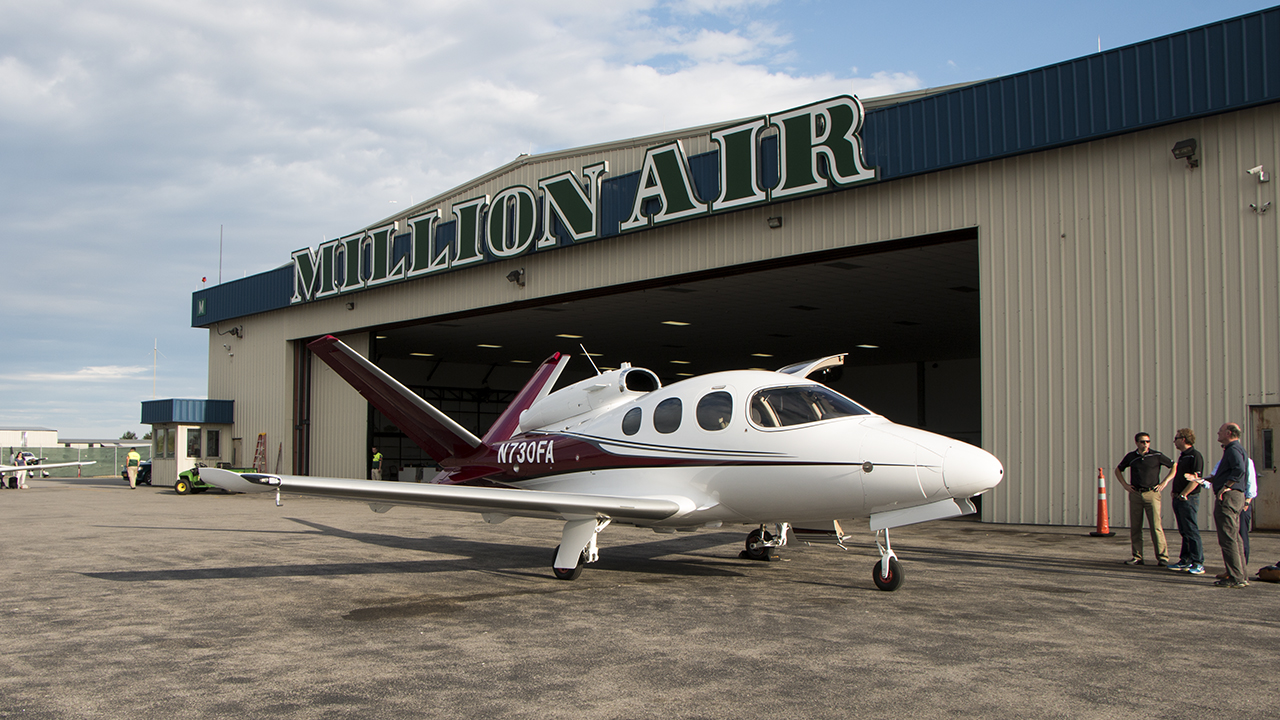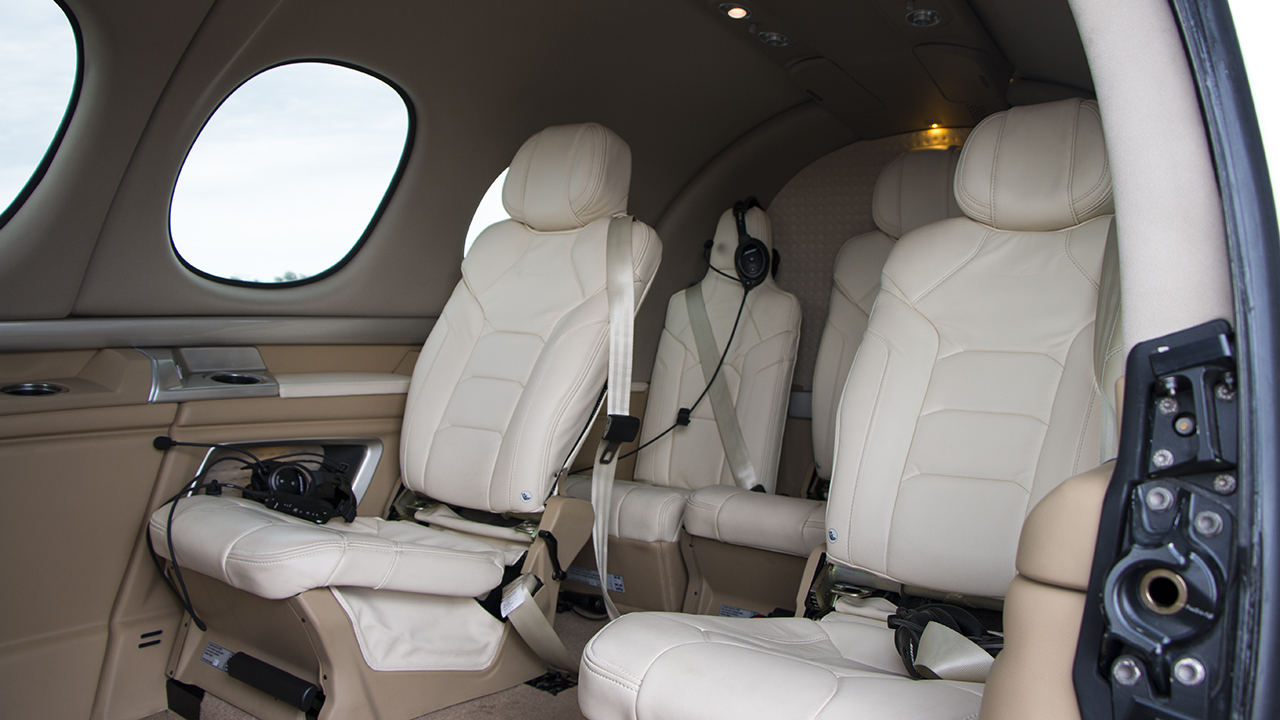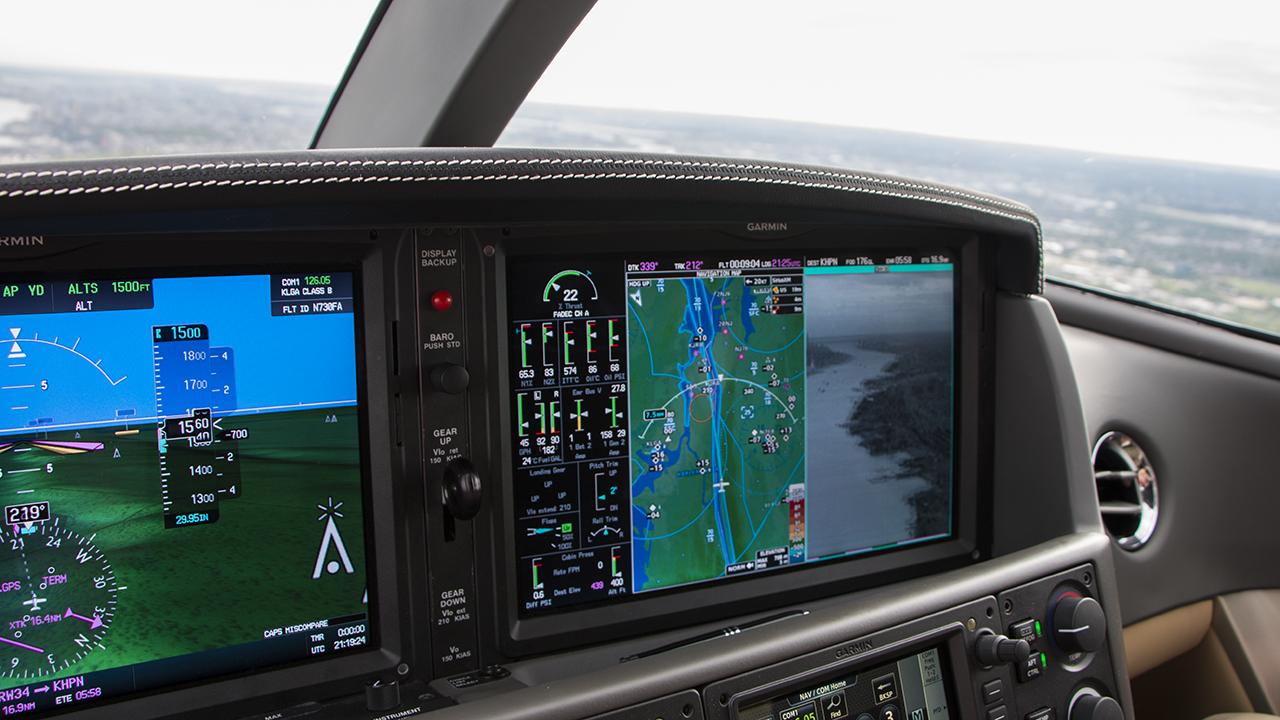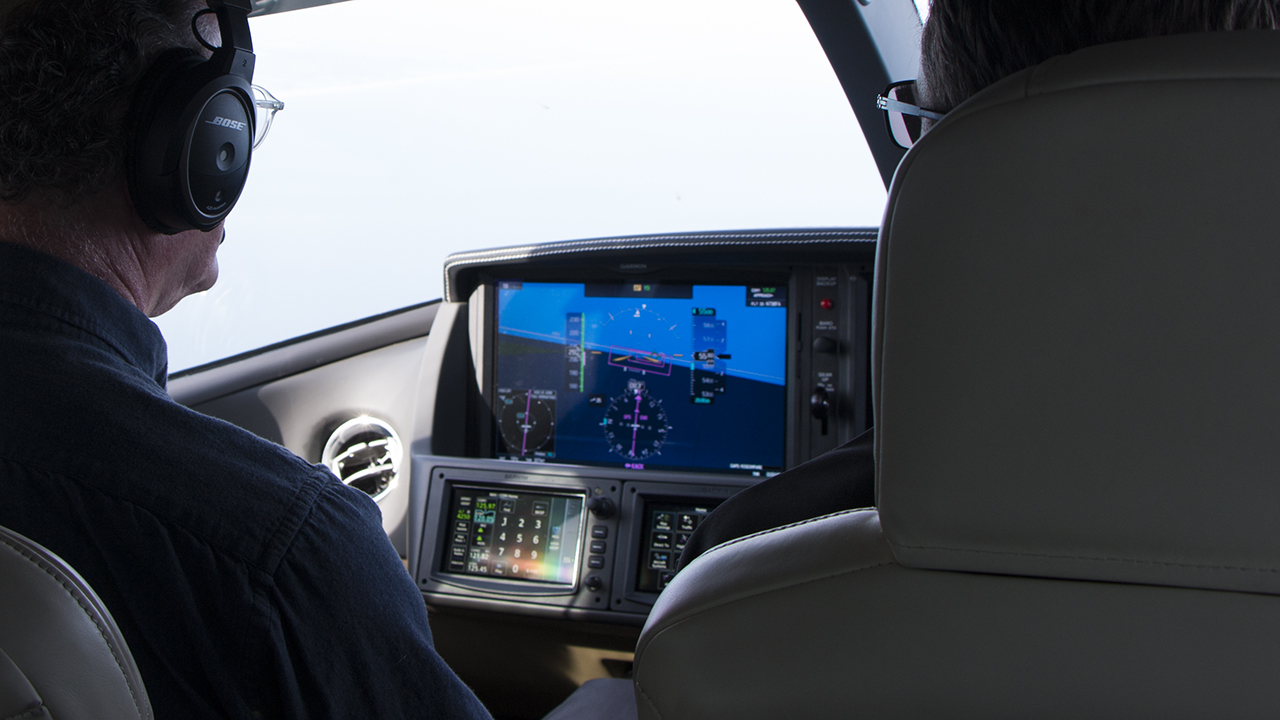Somewhere over the Hamptons, the pilot told me to take the controls. To my left, there was a joystick, roughly the same size and dimension as my favourite ’90s arcade game, After Burner. I clutched it, pulled back, and felt the jet climb.
All photos: Adam Clark Estes
“Now try to stay inside the boxes,” the pilot said, pointing at a touchscreen in the cockpit. “It’s a lot like Flight Simulator 2000.” And it was, except we were in an actual jet — the world’s newest and smallest, in fact — soaring thousands of feet above the Atlantic Ocean, very much flying. I didn’t even consider the idea that we might crash.
That’s how the Cirrus Vision Jet is designed. It’s supposed to be supremely safe, exceptionally easy-to-fly for a single pilot, and generally futuristic. With a price tag of just under $US2 million ($2.7 million), the Vision Jet is not only the smallest jet on the market, it’s also the most affordable. Well, “affordable” in the sense that Learjet’s newest, most modern aircraft costs over $US20 million ($27 million). Cirrus told me that the company hopes to attract customers that don’t want to spend eight figures on a private jet but also want something more sophisticated and versatile than a prop plane. Me, I feel like I splurged when I bought a new bicycle for $930.
But this jet is next-level. Unlike prop planes that have speed and altitude limitations, the Vision Jet is capable of cross country flights, albeit with a few stops. With a maximum cruise speed of 300 knots (555km/h) and a range of 1850km, the aircraft is hardly a puddle jumper. In fact, you could fly from Newark to Miami in a Vision Jet (barely) without touching down. And based on your option package, you could also install a bathroom in the Vision Jet’s cabin, just in case you need to relieve yourself along the way. Oh, also, the aircraft is designed to be piloted by you, so that adds extra fun to your $2.7 million investment.

Aside from the price point, what really sets the Cirrus Vision Jet apart is its promise to be a personal aircraft. Not only does the company want its customers to avoid the hassle and expense of employing two pilots to travel; Cirrus actually wants the jet’s owners to learn how to fly with minimal training. They will still have to go through the process of earning a pilot’s licence to abide by Federal Aviation Administration (FAA) regulations in the US and Civil Aviation Regulations in Australia, but after that, the Vision Jet essentially flies itself in the air. In other words, the pilot has to take off and land. The plane does the rest.
That’s the sales pitch, anyway. Before my flight, I sat down with Ben Kowalski, vice president of marketing and communications for Cirrus, who took me through a couple of dozen slides, explaining everything from the company’s founding in a Wisconsin barn to the invention of a ballistic parachute that guides Cirrus aircraft safely to the ground in the event of a catastrophic equipment failure. Now, I was starting to get nervous about flying in a brand new plane built by this company I’d never heard of.
“Enough with the slides,” Kowalski said, as if on cue. “You probably want to fly the Vision Jet already, huh?”
Pre-Flight Checklist
As we walked through the hangar of the private airport, a facility in Westchester County called “Million Air”, my palms were sweaty. I wouldn’t say I’m afraid of flying. I’m just an anxious person in general. So you can imagine how climbing into an aircraft that’s roughly the size of a large SUV would give me butterflies. I’d never even been in a private plane, let alone the world’s smallest jet.

The door of the Vision Jet opens like a clamshell with the window half going up and the stairs dropping down onto the tarmac. I climbed up and hopped into the pilot’s seat, as Kowalski explained how the modular seating could be rearranged to accommodate as many as seven people or just two and extra cargo, like skis. I said something like, “Wow,” and then noted how the cockpit with its supple leather captain’s chairs simply reeked of rich people.
“You want to press that button to your left to start the jet engine,” the pilot told me.
“This one?” I replied sheepishly. He nodded, and I pushed it. The engine whirred to life, and I joked, “That was my first time!”
“It never gets old,” the pilot said, smiling.

We taxied towards the runway, and Kowalski bragged about how the Vision Jet needed just a little over 610m for takeoff, while a commercial jet would need many multiples of that distance. It wasn’t until we were sitting on top of those familiar white stripes that I realised I’d never seen this point of view before. Stretched out in front of me were over 1830m of asphalt and a blue sky that looked higher than ever. The pilot punched the thrust lever, a cute little thing about the size of a modern car’s gear stick, and the jet engine screamed. Before I knew it, we were airborne, bobbing a little in the early summer breeze and then soaring over the mansions and golf courses of Westchester County.
Our initial destination: The Hudson River, where we could get an unparalleled aerial view of Manhattan. I’d recently seen the movie Sully, starring Tom Hanks and a white, pencil-thin moustache. But once we gained some altitude, the little plane steadied, and I marvelled at how much I could see from the Vision Jet’s signature oversized windows. With vistas at every angle, I really had never been able to see so much from an aeroplane cabin before. A whimsical thought took me back to Willy Wonka and his glass elevator, though some intermittent turbulence quickly brought me back to reality.
In-Flight Entertainment
There’s a good, engineering-based explanation for the Vision Jet’s huge windows. Like the rest of the Cirrus lineup, the plane’s fuselage is completely carbon fibre, making it extremely lightweight and capable of holding roomier cabins and larger windows. The Vision Jet itself also places the jet engine, a compact piece of machinery with 816kg of thrust built by Williams Aviation, in a “piggyback” position, right on top of the aircraft, in front of the tail. Cirrus says this cuts down on noise, although everyone still has to wear aviation-grade noise-cancelling headphones in order to carry on a conversation. When we flew over the George Washington Bridge and right up next to Manhattan, though, I was speechless.

It’s a shame all planes don’t let you see the world like this, I thought. Flying in a commercial jet is enough of a luxury — albeit a sometimes dreadfully oppressive one — that you forget how magical it is that mankind builds these massive machines that enable them to touch the clouds. I’ll probably never fly in a private plane again, which is why I sort of tuned out as the pilot was explaining the mosaic of touch screens in the cockpit. I wanted to drink in this view I’d never see again. But in the end, the so-called Cirrus Perspective Touch avionics system by Garmin did steal my attention. The setup looked like the future of aviation. It also looked like a goddamn video game in an awesome way.
At this point, I took stock of all the instrumentation around me. To my left, there was the joystick, the button to start the jet engine, and an air vent for climate control. It’s honestly seemed a lot like a new car, in some respects. The thrust lever — think throttle — is in the centre console where the gear stick would be in an automobile, with some knobs above that can be used to set the altitude. The rest of the cockpit is essentially just five touchscreens that can display whatever kinds of information you want to see.
My favourite screen showed off the features of Garmin’s Synthetic Vision Technology (SVT). Using an array of sensors installed on the aircraft, this feature identifies and avoids obstacles and hazards that might ruin your day while flying a $2.7 million aircraft. Unlike rudimentary radar readouts you’ve seen in movies, though, the display actually shows an 3D model of your surroundings and also provides basic information about your flight, like altitude and air speed.

If you’re flying in bad weather — fog, rain, regular old clouds — the Vision Jet comes with an Enhanced Vision System. This uses visible and infrared light to give you a pretty good understanding of your surroundings. The lens that powers it is even heated so that it doesn’t get covered in ice up in cold weather.
But as Kowalski explained to me on the ground, pilots ideally wouldn’t even have to use these features since the Vision Jet’s autopilot is so sophisticated. As we cruised over Coney Island and under the busy commercial air traffic for LaGuardia, the pilot explained that the autopilot essentially worked like the touch-to-fly feature you see on consumer drones.
“Want to go to Nantucket?” he said. I told him I did, and he pulled up the flight map on one of the screens. “Just zoom in to the airport here, tap, and you’re on your way.”
This felt impossible to me. What is this future in which you touch a screen and an aeroplane takes you to a fantastic island, famous for whaling and red pants? It felt like witchcraft, except it wasn’t. According to my test pilot, the technology available in Vision Jet cockpit far surpassed what commercial pilots have access to. It’s hard for me to know how true that is without trying to fly a commercial jet, but I didn’t doubt that the Cirrus aircraft featured next generation technology, something no one I know could afford. If history is any evidence, this stuff gets cheaper.
This Is Your Captain Speaking
Not long after that impressive Nantucket demo, the pilot told me to take control. Let’s make one thing clear: I am not a pilot. I have flown a large number of drones, largely without incident, but until my day in the Vision Jet, I had never flown an aeroplane. All that changed in half a second, when I pulled back on the joystick and brought the Vision Jet up to the “highway in the sky”.
Developed by NASA in the late 1990s, the highway in the sky is basically exactly what it sounds like: A designated path for aircraft to travel safely from one destination to another. On a cockpit display, the virtual highway typically looks like a series of boxes through which the pilot must guide the aircraft to stay on the right course. Synthetic vision systems like the one on board the Cirrus aircraft actually make the highway in the sky look a little bit like Mario Kart, except there are no cool sounds when you clear a box.

If anything, the highway in the sky interface seems like a great teaching tool. I realised that the Vision Jet would fly itself if I let go of the joystick, but in the few minutes that I fancied myself a student pilot, the video game-like guidance made immediate sense to me. I got a feel for how the aircraft responded to the wind as well as my controls. I gained a new sense of my surroundings, though it sometimes felt scary to pull my eyes away from the display. In the end, I liked flying a jet. I liked it a lot.
The bundle of nerves that twisted up my stomach before takeoff had disappeared by the time the pilot took back the controls and made the turn back towards Westchester. Underneath me I saw the sprawling Long Island seaside estates and wondered how many of them would want to buy a personal jet and learn to fly.
After all, the Vision Jet is an impossible dream for people like me. It isn’t even one I’d want to pursue. Nevertheless, the aircraft feels like a glimpse into the future of aviation and perhaps even transportation. It’s hardly a flying car. But it’s a lot closer to that idea than anything else I’ve ever seen.
